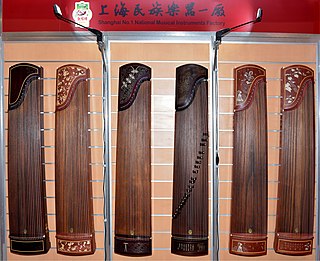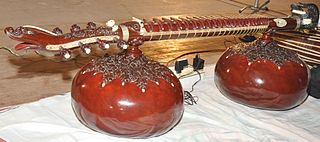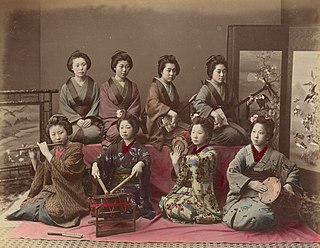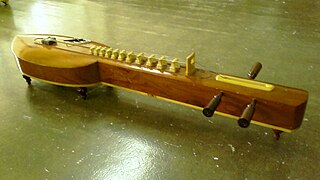Related Research Articles

Zithers are a class of stringed instruments. Historically, it could be any instrument of the psaltery family. In modern terminology, it is more specifically an instrument consisting of many strings stretched across a thin, flat body, the topic of this article.

The geomungo or hyeongeum is a traditional Korean plucked zither with both bridges and frets. Geomungo is a representative stringed instrument made in Goguryeo before the 5th century. Scholars believe that the name refers to Goguryeo and translates to "Goguryeo zither" or that it refers to the colour and translates to "black crane zither".

The zheng or guzheng, is a Chinese plucked zither. The modern guzheng commonly has 21, 25, or 26 strings, is 64 inches long, and is tuned in a major pentatonic scale. It has a large, resonant soundboard made from Paulownia wood. Other components are often made from other woods for structural or decorative reasons. Guzheng players often wear a fingerpick made from materials such as plastic, resin, tortoiseshell, or ivory on one or both hands.

The Rudra veena —also called Bīn in North India—is a large plucked string instrument used in Hindustani Music, especially dhrupad. It is one of the major types of veena played in Indian classical music, notable for its deep bass resonance.

Traditional Korean musical instruments comprise a wide range of string, wind, and percussion instruments. Many traditional Korean musical instruments derive from Chinese musical instruments.

Traditional Japanese musical instruments, known as wagakki (和楽器) in Japanese, are musical instruments used in the traditional folk music of Japan. They comprise a range of string, wind, and percussion instruments.
Traditional Vietnamese musical instruments are the musical instruments used in the traditional and classical musics of Vietnam. They comprise a wide range of string, wind, and percussion instruments, used by both the Viet majority as well as the nation's ethnic minorities.

The mi gyaung or kyam is a crocodile-shaped fretted, plucked zither with three strings that is used as a traditional instrument in Burma. It is associated with the Mon people. Both Burmese and Mon names also mean 'crocodile.'

The chakhe or krapeu also called takhe, is a fretted floor zither or lute with three strings used in Thai and Khmer music. The Thai and the Khmer instrument are virtually identical.

The sasando, also called sasandu from Sandu or Sanu, is a tube zither, a harp-like traditional music string instrument native to Rote Island of East Nusa Tenggara, Indonesia.

Bamboo's natural hollow form makes it an obvious choice for many musical instruments. In South and South East Asia, traditional uses of bamboo the instrument include various types of woodwind instruments, such as flutes, and devices like xylophones and organs, which require resonating sections. In some traditional instruments bamboo is the primary material, while others combine bamboo with other materials such as wood and leather.
An idiochord is a musical instrument in which the "string" of the instrument is made from the same material as its resonating body. Such instruments may be found in the Indian Ocean region, disparate regions of Africa and its diaspora, and parts of Europe and North America.
The karaniing is a type of bamboo tube zither played among the Orang Asli tribal peoples of Malaysia.
The takumbo is a parallel-stringed tube zither made from bamboo, and is found in the Philippines. It is made from a heavy bamboo tube about 40 cm long, with both ends closed with a node. Two strands of strings, about 5 cm apart, are partially etched out from the body of the bamboo. Small wooden bridges are inserted beneath the strings at both ends. At the center of the bamboo tube, below the strings, a small hole is bored. The small hole is covered with a bamboo plate clipped to the strings.
The kolitong is a bamboo polychordal tube zither from Bontok, Kalinga, Philippines with six strings that run parallel to its tube body. The strings are numbered from one to six, from lowest to highest pitch. The body acts as the instrument's resonator. The body may be a whole tube or a half tube. In both cases, the two ends of the body are closed by the bamboo nodes. To help with the resonance of the instrument, holes are made on both nodes and long cracks are made along the body parallel to the strings.

The kong ring or gung treng is a Cambodian tube zither, in which a tube of bamboo is used as a resonator for stings that run along the outside of the tube, lengthwise. It has the same musical purpose as the "bossed gongs" and may substitute for them and accompany singing. Although it is a traditional instrument with a long history, it has been improved on in modern times. The kong ring is represented by similar instruments in other countries of South Asia and the Pacific.

The tube zither is a stringed musical instrument in which a tube functions both as an instrument's neck and its soundbox. As the neck, it holds strings taut and allows them to vibrate. As a soundbox, it modifies the sound and transfers it to the open air. The instruments are among the oldest of chordophones, being "a very early stage" in the development of chordophones, and predate some of the oldest chordophones, such as the Chinese Se, zithers built on a tube split in half. Most tube zithers are made of bamboo, played today in Madagascar, India, Southeast Asia and Taiwan. Tube zithers made from other materials have been found in Europe and the United States, made from materials such as cornstalks and cactus.
The Yalamber or Yahamber Baja is a Nepali tube zither in the Kirati tradition. It is one of three tube-zithers documented in Nepal by the Nepali Folk Musical Instruments Museum in 2004.

The eka-tantrī vīṇā was a medieval tube-zither veena in India, with a single string and one or more gourd resonators. The instrument became prominent in Indian music in about the 10th century C.E. as instruments of court music. Alongside the alapini vina and kinnari vina it replaced the harp-style veenas and lute-style veenas in sculpture. It was possibly a forerunner of the rudra vina. It shares its name with the modern single-string drone lute, the ektara.

The ālāpiṇī vīṇā was a medieval stick-zither veena in India, with a single string and a gourd resonator. Later forms added more strings. The instruments became prominent in Indian music after 500 C.E. as instruments of court music. Alongside the eka-tantri vina and kinnari vina it replaced the harp-style veenas and lute-style veenas. The instruments were used in Southeast Asia, both mainland and island nations, and were recorded in sculpture and relief sculpture.
References
- ↑ Patricia Ann Matusky; Sooi Beng Tan (2004). The Music of Malaysia . Ashgate Publishing, Ltd. pp. 298–. ISBN 978-0-7546-0831-8 . Retrieved 24 October 2012.
- ↑ Ghulam-Sarwar Yousof (2004). The Encyclopedia of Malaysia: Performing arts. Archipelago Press. p. 71.